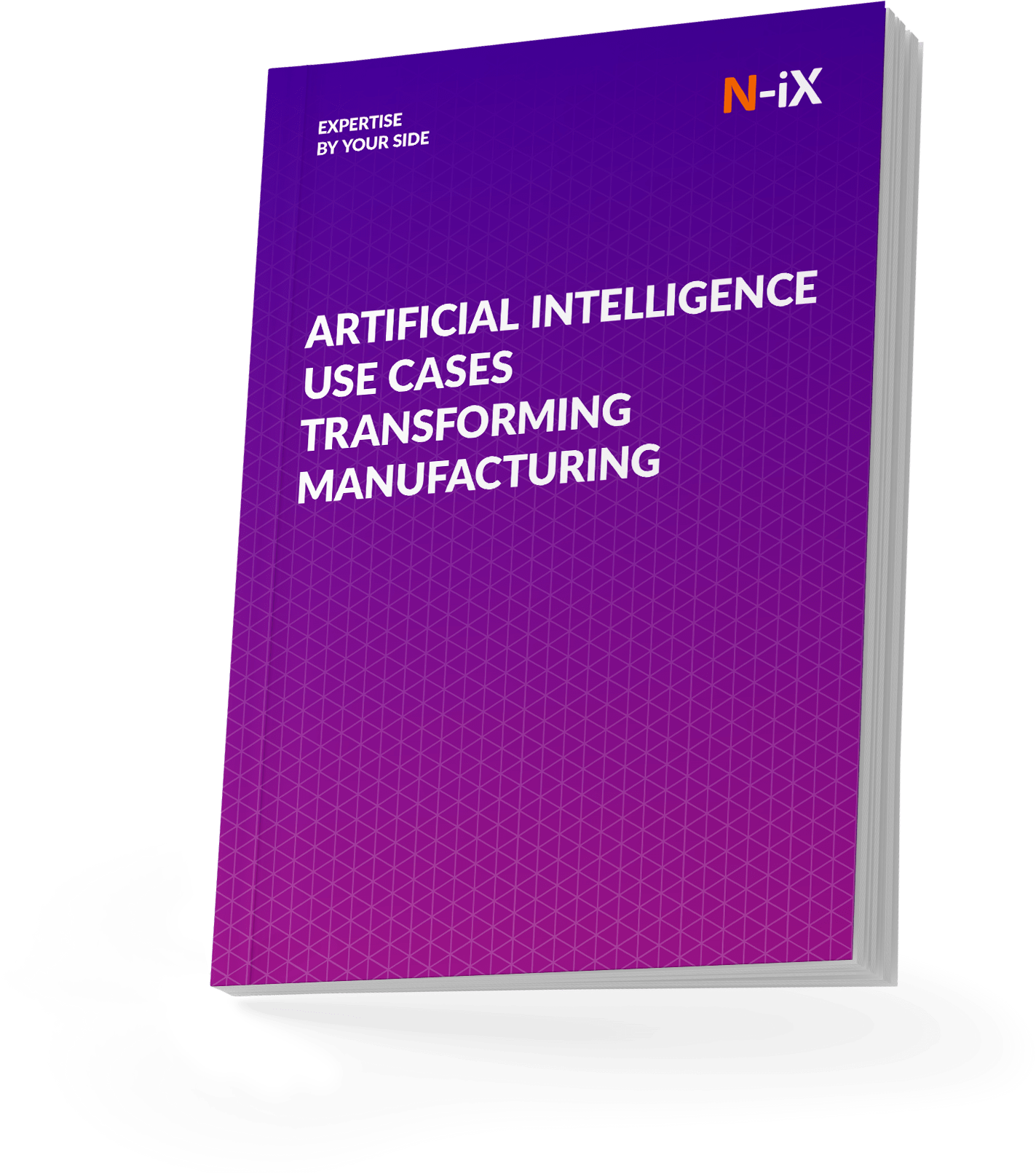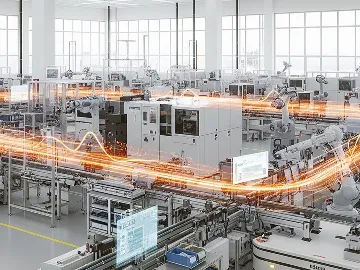The Internet of Things and smart manufacturing have long become one of the most talked-about duos among the producers of various goods-from machinery to food and medicine. And for a reason.
IoT is among the top technologies enabling manufacturers to reach a new level of connectivity and operation control and enter Industry 4.0 and Industry 5.0.
Integrated with existing manufacturing software solutions, IoT allows for effective real-time data collection, seamless communication, and advanced analytics. These capabilities empower smart manufacturers to automate processes, ensure consistent quality, and improve efficiency across the entire value chain. As with any tech adoption, the process of reaching the mentioned benefits may pose a few challenges.
Below, we'll review the reasons for adopting IoT in smart manufacturing, the top smart manufacturing operations you can enhance with IoT, and how our full-cycle IoT development services and expertise in IoT can help businesses avoid costly mistakes. First, let's review why we should differentiate between traditional and smart manufacturing.
Difference between manufacturing and smart manufacturing
Traditional manufacturing has long focused on efficiency and high-volume output, relying on assembly lines and mechanized systems to minimize costs. These systems are built for repetition-designed to minimize costs and maximize productivity. Despite being reliable, they often lack the flexibility needed to adapt to changing consumer demands or accommodate customization. As consumer demand shifts toward customization, the rigidity of these systems highlights their limitations, prompting a move to more adaptable, advanced methods.
Smart manufacturing, on the other hand, uses AI, IoT, and cloud computing to create connected, intelligent production ecosystems prioritizing automation and optimization along the value chain. It leverages real-time data to optimize everything from design to delivery, enabling automated processes and smarter decision-making. For smart manufacturing, achieving smooth interaction and integration of the digital, physical, and human realms is essential. It allows the businesses to converge their IT and OT operations and increase process visibility and uninterrupted data flow.
Since connectivity and data transmission between machinery, software solutions, and users is the basis for creating intelligent connected systems, the value of the Internet of Things in smart manufacturing becomes indisputable. Here's why this technology is the key to making production sites smarter.
IoT use cases in the context of smart manufacturing
The Internet of Things has transformed how modern factories operate and innovate. Here are a few use cases of IoT in the smart manufacturing industry.
Disparate device connectivity
IoT in smart manufacturing helps connect machines, sensors, and systems, and achieve seamless communication and data exchange across every aspect of the production process. This connectivity allows to establish a dynamic ecosystem where real-time insights drive efficiency, precision, and scalability.
Data collection
Smart manufacturing IoT helps collect data from various devices across the production chain and analyze it with AI and ML-powered analytics tools. It enables companies to gain insights into machine performance, inventory tracking, quality control, and other processes.
Interoperability
Adopting IoT for smart manufacturing businesses can also help achieve device and data interoperability. By integrating disparate components and devices, companies will have greater visibility and remote control.
There are various processes that can be enhanced with IoT in the smart factory landscape. Let's review the most common ones.
Typical smart manufacturing processes you can improve with IoT
In smart manufacturing, processes are interconnected, data-driven, and automated to enhance efficiency, productivity, and quality. Leveraging technologies like IoT, AI, robotics, and cloud computing, smart manufacturing transforms traditional operations. Here's a list of processes that can be improved with IoT in smart manufacturing.

Data collection and real-time monitoring
Adopting solutions powered with IoT sensors and edge devices provides the manufactury managers with data from machinery, production lines, supply chains, and other connected departments. In addition, it allows for real-time monitoring, especially when it's necessary to ensure workers' safety and equipment health. Moreover, it enables further IoT data visualization, necessary for sharing insights across integrated tools and improving collaboration.
Example: Sensors can monitor machine temperature and send it to ML and AI algorithms to calculate the equipment's health, predict failures, and estimate the maintenance time. Another example may be smart tags tracking the materials and products throughout production.
Transform your manufacturing processes with AI: Discover key use cases in the white paper!


Success!

Predictive maintenance
IoT allows machine operators to monitor machine failure parameters and analyze this data with AI and ML-powered solutions, making predictive maintenance possible. It helps identify equipment issues, prevent machinery failures, reduce unplanned downtime, and extend equipment lifespan. Moreover, manufacturers can use IoT systems to establish uninterrupted workflows and stay flexible during maintenance operations.
Example: By detecting vibration and heat anomalies in machinery, IoT solutions can alert the personnel of potential equipment damage so the maintenance team can repair it before its breakdown creates bottlenecks.
Production optimization and automation
Businesses can collect, monitor, and analyze production data with advanced analytics and AI tools by equipping machines and systems with IoT sensors. It allows production site managers to identify inefficiencies and optimize workflows, resource usage, and production speed.
Combined with robotics, IoT enables production line automation, helping businesses increase productivity and set up real-time adjustments thanks to seamless machine-to-machine (M2M) communication.
Example: Robotics and IoT-enabled automated production lines can adjust their tasks based on real-time input. It helps increase assembly speed and accuracy, which is critical for high-risk items.
Explore the topic: The Internet of Robotic Things: Key use cases and benefits
Supply chain optimization
IoT-enabled tracking systems provide end-to-end visibility of materials, components, and finished products across the supply chain. This data allows businesses to improve collaboration with suppliers, optimize logistics, and improve forecasting to ensure a steady flow of goods.
Example: IoT-enabled smart manufacturing solutions can monitor shipments across the whole supply chain. Powered with GPS and wireless sensors, they help businesses streamline the delivery process and minimize delays.
Smart inventory management
In smart manufacturing, inventory is everything the business should restock to continue the production of items. It includes raw materials, tools, equipment, utilities, and finished products. Adopting IoT for inventory management in smart manufacturing allows businesses to track the item location and levels in real-time, automate replenishment, collect data for delivery route optimization, and more.
Example: Aerospace manufacturing companies use IoT to manage inventory, track parts, and streamline procurement. Having sensors on the tools and components ensures that engineers and assembly line robots have the necessary equipment and parts at the designated areas to improve assembly efficiency.
Digital twins simulations
Digital twins are virtual replicas of physical assets, processes, or systems to simulate, monitor, and optimize their performance. IoT provides these replicas with real-time data collected by sensors for businesses to visualize, analyze, and predict performance in a virtual environment. It helps manufacturers conduct risk-free experiments, simulate equipment failure scenarios, create risk management plans, test new production setups, and explore optimization possibilities while maintaining ongoing operations.
Example: Car manufacturers can simulate production line changes to predict bottlenecks before implementing them in the physical factory.
Quality control and defect detection
IoT applications in smart manufacturing often include integration with other technologies, and computer vision (CV) and AI are among the most popular ones when it comes to quality control and process supervision. IoT smart cameras with on-device AI algorithms continuously inspect items during production to identify defects or inconsistencies.
Example: AI-powered smart cameras on the car assembly line automatically scan the condition of the automotive part to ensure final product quality, which, in turn, minimizes waste, returns, and risks.
Utility management and smart metering
Integrating IoT in smart manufacturing helps manufacturers set up smart metering systems to monitor water, gas, and electricity consumption across production lines and facilities. As a result, it optimizes utility usage, minimizes waste, and lowers operational costs. Moreover, smart metering solutions allow smart manufacturing businesses to retrieve data for ESG reporting and stay compliant.
Example: A food and beverage company using smart meters for utility and waste management can adjust energy, water, and gas supply to match production demands in real time. In addition, it can use the data to report on their progress regarding ESG and meeting their sustainability initiatives.
Human-machine collaboration
IoT enables seamless communication and real-time data sharing between workers and machines. Collaborative robots (cobots) and Human-Machine Interfaces (HMIs) help human operators with repetitive tasks and allow for better decision-making through data insights. In addition, HMIs provide operators access to live performance metrics, so they can detect anomalies and adjust settings instantly.
Wearable devices and AR tools provide workers with actionable insights and step-by-step guidance, improving productivity and reducing errors. IoT sensors also monitor workplace conditions, sending safety alerts whenever there's a risk of a machine malfunctioning.
Example: In automotive, a cobot helps engineers assemble parts while IoT dashboards display live performance metrics. These insights allow teams to optimize workflow and detect anomalies to prevent machinery malfunctioning and ensure environmental safety.
Worker safety and efficiency
Businesses also use IoT in the smart manufacturing industry to ensure employee safety. Mountable sensors, such as smart cameras and smoke detectors, together with wearable devices, such as smart hard hats and wearable sensors, monitor worker safety in hazardous environments and detect dangerous conditions.
Example: Gas and oil producers use IoT solutions to monitor gas leaks, temperature, and worker vital sign metrics on drilling sites. It helps prevent accidents as the solutions send alerts immediately if unsafe conditions are detected.
In smart manufacturing, IoT-enabled systems and advanced technologies drive interconnected processes that deliver real-time insights, predictive capabilities, and enhanced control. Effective predictive maintenance, energy optimization, and other processes enable manufacturers to boost productivity, minimize costs, and meet dynamic market demands.
Despite the benefits, smart manufacturing leaders don't rush into company-wide IoT adoption due to its complexity, especially in facilities with established processes and in-use machinery. However, these challenges can be handled with a knowledgeable and skilled tech partner by your side. Here's how N-iX would approach them.
Explore more: Industrial IoT: best practices and key use cases
Top 4 IoT smart manufacturing challenges you can solve with N-iX
The success of adopting or transforming IoT solutions in smart manufacturing includes various ingredients, such as IoT development team skills, hardware and software quality, workshops for end-users, and so on. It also depends on how well manufacturers deal with possible pitfalls that could put the whole project at risk. Here are the three major challenges a smart manufacturing business should consider-and the strategies to prevent them.

Lack of device and data interoperability
Large factories usually have a lot of costly machinery that, despite their age, still function well. When it comes to IoT adoption, many businesses think they would need to replace their machinery, but this is not always the case. In fact, N-iX can develop solutions that would integrate different devices and ensure device interoperability for smoother management.
Moreover, connecting disparate devices may create chaos regarding data collection and processing. However, with the help of proper data strategy, tech partners like N-iX can design data processing solutions that securely send data to the cloud for further analysis.
Unsuitable hardware selection
According to the Eseye 2024 State of IoT Adoption report, 58% of respondents consider issues at the device level a reason for their IoT project failures. To avoid a similar scenario, you should consider plenty of factors when choosing or designing hardware for IoT solutions in smart manufacturing. They include facility planning, connectivity requirements, business objectives, battery management (if applicable), and others. The list may differ depending on specific project needs.
We at N-iX help you choose the most suitable hardware for your IoT solution. In addition, we also design and create custom hardware to solve your unique challenges and prepare your tech infrastructure to solve modern challenges.
Unbalanced team composition
Having the option to choose among the cooperation models usually solves the problem of an unbalanced skill set in the team. You don't have to hire a whole IoT development team if your in-house tech department lacks only a few IoT engineers with specific skills to do the job. Just as you don't need to hire a full in-house team if you don't plan for them to stay in your company longer than the project requires. This flexibility helps smart manufacturing businesses optimize their budgets and hire only the necessary people.
For example, N-iX offers three cooperation models: Extended Team, Managed Team, and Custom Solution Development. It ensures you choose the best-fit option for your project based on how much you want to be involved in the development or what skills your in-house team needs. In addition, you can request IoT consulting services, and our team of BA, IoT architects, and software engineers will advise you on the optimal team composition for your project.
IoT layers vulnerability
The IoT system safety is a top priority for any business adopting this technology. However, as cybersecurity experts like to say, the system security is as strong as the security of each individual component. In the IoT case, the security of the whole solution is as strong as the security of each IoT layer.

At N-iX, we suggest involving DevSecOps specialists in the development process to assure security at every development stage. In addition, we offer various IoT security services, including planning and executing post-installation maintenance, and firmware and software updates, to keep your IoT solutions up-to-date.
Whether you need to develop a solution end-to-end, assist your team, or leverage our IoT expertise for your project, N-iX is here to assist in the tech journey. Here's how we can be of service when it comes to adopting or modernizing IoT in smart manufacturing.
N-iX's services for more effective use of IoT in smart manufacturing industry
We create custom IoT solutions and help enterprises, including Fortune 500 companies, build solid IoT systems that improve manufacturing process visibility, device and data interoperability, and decision-making. Smart manufacturing businesses that produce goods for automotive, healthcare, agriculture, energy and utilities, and other industries partner with N-iX because we provide full-cycle IoT services, including:
- Consulting on IoT solutions for specific smart manufacturing challenges;
- Establishing a proper network based on the location specifics and business needs;
- Enabling machine-to-machine (M2M) (also known as device-to-device (D2D) communication by integrating the devices;
- Designing hardware prototypes and preparation for device certification;
- Connecting IoT to the cloud to ensure steady data flow and processing;
- Developing solutions for IoT data analytics and visualization;
- Integrating IoT with Big Data, ERP, AI, CV, robotics, AR, and other solutions;
- Ensuring security at each IoT architecture layer (device, gateway, cloud, data, UI/UX);
- Developing mobile apps and UI/UX interfaces;
- Providing automated quality assurance (AQA) and cybersecurity services at each IoT layer;
- Maintaining and updating IoT solutions to ensure stable performance.
We have developed complex custom solutions for global manufacturing leaders, including Fortune 500 businesses. Our team features over 2,400 software engineers skilled in different programming languages and technologies necessary to build a robust IoT solution from scratch. With expertise in embedded software development, IoT cloud integration, cybersecurity, AI, ML, data processing, robotics, sensor fusion, digital twin development, and more, N-iX has everything it takes to bring your project into reality.
N-iX has established partnerships with hyperscalers such as Amazon Web Services (AWS), Microsoft Azure, Google Cloud Platform (GCP). Moreover, we partner with IoT microcomputer and microcontroller manufacturers like Nordic Semiconductor, Arduino, and Raspberry Pi, as well as wireless connectivity company Wirepas. It provides us access to cutting-edge technologies and support throughout the development process to speed up your project's time to market while maintaining high quality.
With N-iX, you get access to the best resources, experienced professionals, and established processes to create an effective IoT solution to resolve your business challenges. Contact our team, and let's discuss how our IoT expertise can benefit your smart manufacturing business!
References:
- Eseye 2024 State of IoT Adoption | Eseye
Have a question?
Speak to an expert




